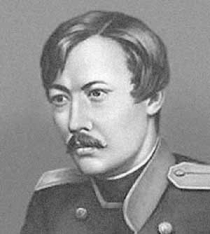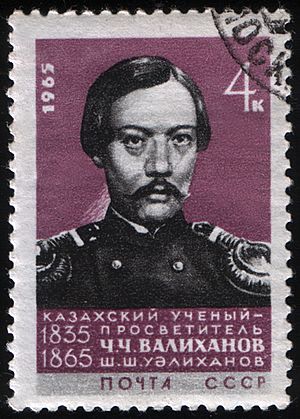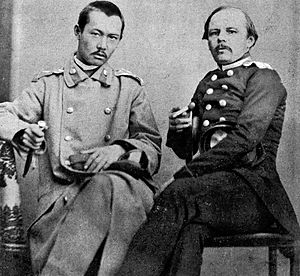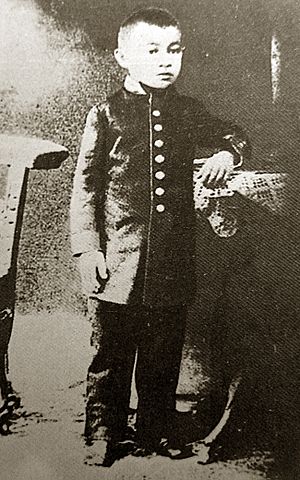Shoqan Walikhanov facts for kids
Quick facts for kids
Shokan Shyngysuly Valikhanov
|
|
|---|---|

A portrait of Shokan Valikhanov in his military uniform
|
|
| Born | November 1835 Kushmurun fort in Kostanay Province
|
| Died | April 10, 1865 (aged 29) Village of Sultan Tezek in Almaty Province
|
| Nationality | Kazakh |
| Other names | Shoqan Walikhanuli, Kazakh: Шоқан Шыңғысұлы Уәлихан, Şoqan Şyñğysūly Uälihan; Russian: Чокан Чингисович Валиханов, given name Mukhammed Kanafiya Kazakh: Мұхаммед Қанапия |
| Occupation | Scholar, Historian, Ethnographer and Folklorist, Officer in Asiatic Department of Ministry of Foreign Affairs |
| Known for | Kazakh historian, ethnographer, and civil servant |
| Spouse(s) | Aisary Walikhanova |
| Parents |
|
Shokan Shyngysuly Valikhanov (Kazakh: Шоқан Шыңғысұлы Уәлихан, Russian: Чокан Чингисович Валиханов), whose given name was Mukhammed Kanafiya (Kazakh: Мұхаммед Қанапия), was a famous Kazakh scholar. He was born in November 1835 and passed away on April 10, 1865.
Shokan was a historian, someone who studies history, and an ethnographer, a person who studies different cultures and peoples. He also took part in a period known as "the Great Game". This was a time when the British and Russian empires competed for power in Central Asia.
Many people consider him the founder of modern Kazakh history writing and the study of Kazakh culture. The Kazakh Academy of Sciences was even named after him in 1960. Sometimes, in English, his name is written as "Chokan Valikhanov." This comes from how his name was spelled in Russian.
Early Life and Education
Mukhammed Shoqan Shyngysuly Qanafiya Walikhanov was born in November 1835. His birthplace was the Kushmurun fort in what is now the Kostanay Province of Kazakhstan. He came from a very important family. He was a direct descendant of Genghis Khan, a famous historical leader. He was also a descendant of Ablai Khan, a powerful ruler of the Kazakh Middle Jüz.
Shoqan's family was highly respected by the Russian Empire. His father held several important positions. He was a senior Sultan and an advisor to the frontier board.
Childhood Education
Shoqan spent his early years in his father’s traditional yurt, a type of tent. His father, Chingis, made sure he started school early. In 1842, at age six, Shoqan went to a small private school called a maktab. This school taught general subjects, not just religious ones. Here, he began learning the Kazakh language, which was written using the Arabic script back then.
Later, Shoqan moved to his paternal grandmother Aiganym's home in Syrymbet. His grandmother then enrolled him in the Siberian Cadet Corps.
Military Academy in Omsk
In 1847, Walikhanov joined the military academy in Omsk. At this school, he studied not only Russian but also English literature. After graduating, he traveled widely in Central Asia in the late 1850s. It was in Omsk that Walikhanov first met the famous writer Fyodor Dostoyevsky.
Adult Life and Explorations
Walikhanov's work often combined military intelligence with exploring new places. His first successful journey was in 1855-1856 to the Issyq Köl region. After this, he was called to the capital city, St. Petersburg, in 1857. There, he reported on his findings and was chosen to join the Russian Geographical Society.
Journey to Kashgar
Walikhanov went on an important expedition to Kashgar in 1858-1859. This journey was very risky. He traveled in disguise, pretending to be a merchant. He gathered valuable information about the region.
The expedition ended in April 1859 due to growing suspicions. Walikhanov returned to St. Petersburg. He became a well-known figure in the city's intellectual and cultural scene. He stayed there from 1860 to the spring of 1861. Walikhanov believed in Westernization, which meant adopting European ideas and ways of life. He also openly criticized the strong influence of Islam in his homeland.
Later Years and Health Challenges
In the spring of 1861, Walikhanov became very ill with tuberculosis. This is a serious lung disease. He had to leave St. Petersburg and returned to his home region, hoping to get better. He never went back to St. Petersburg. His health problems kept him from advancing his career.
In letters to his friend Dostoevsky, Walikhanov talked about wanting to return to St. Petersburg. He also tried to get a political job in Tobolsk, like his father. In 1862, he successfully ran for senior Sultan. However, the Governor-General, Alexander Duhamel, did not approve his position because of Walikhanov's poor health.

In 1863, Walikhanov collected information on Kazakh legal practices. This was part of a government project. It led to a document called the 1864 Memorandum on Judicial Reform. In 1864, Shoqan was asked to help Colonel Cherniaev with his military actions in Central Asia. Cherniaev's forces marched from the fortress of Vernoe (now Almaty). They planned to attack the fort at Aulie-Ata (modern-day Taraz). Shoqan tried to get them to negotiate peacefully, but it did not work.
Cherniaev won an easy victory. Shoqan then left Cherniaev's group. He stopped in Vernoe and then moved to the village of Sultan Tezek. This village was near the Ili River. Colonel Cherniaev was still pleased with Walikhanov's work and suggested he be promoted.
Final Months and Legacy
Shoqan spent his last months in the village of Sultan Tezek. He married Sultan Tezek’s sister, Aisary, during this time. He also wrote letters to General Kolpakovski, a military governor. These letters discussed Muslim revolts in nearby Qulja. Kolpakovski respected Shoqan so much that he offered him a job once his health improved.
Sadly, Walikhanov passed away from his illness on April 10, 1865. He was only 29 years old. He was buried in the Kochen-Togan cemetery in present-day Almaty Province.
Nikolay Veselovsky, who edited Walikhanov’s works in 1904, described his short life. He said Walikhanov was like "a meteor flashing across the field of oriental studies." This means he made a brilliant, quick impact.
Walikhanov and Dostoevsky

While in Omsk, Fyodor Dostoyevsky met Shoqan Walikhanov. Dostoevsky thought Walikhanov was a very smart and brave person. He saw him as a great scholar, ethnographer, and storyteller. In their letters, both men showed great respect and admiration for each other.
When Dostoevsky was serving in Semey (then called Semipalatinsk), he met Walikhanov again. They were also friends with other important people. These included the famous geographer Pyotr Semyonov-Tyan-Shansky and Baron A. E. Wrangel.
Today, there is a statue of Walikhanov and Dostoevsky in the city of Semey, Kazakhstan. It stands near the local Dostoevsky museum.
Major Works and Contributions
Walikhanov wrote many articles and books. These works focused on the history and culture of Central Asia. Here are some of his important writings:
- "Chinese Turkestan and Dzungaria: Walikhanov and other Russian travellers"
- "Traces of Shamanism among the Kazakhs"
- "Regarding the camps of Kazakh nomads"
- "The Qazakhs"
- "Tengri" (about an ancient religion)
- "Forms of Kazakh Traditional Poesy"
- Issyk-Kul Travel Journal
- Kul-Ju Travel Journal
- "Notes on jungars"
Walikhanov also collected epic poems. One famous one is "Kozy-Korpesh - Bayan-Sulu." He also recorded the first known version of the Epic of Manas. He called it the "Iliad of the Steppe."
His report about his trip to Kashgar in 1858-1859 is still very important. It describes the situation in Xinjiang after Wali Khan's invasion. It also shows what the region was like just before the Muslim Rebellion of the 1860s.
The Shoqan Walikhanov Spring
The Shoqan Walikhanov spring is located in the Altyn-Emel National Park. It is in the Kerbulak district of the Almaty region. The spring is on the road to the Singing Dunes, at the foot of the Maly Kalkan Mountains.
The spring is named after Shoqan Walikhanov. His journey from Russia to Kashgaria in 1856 passed through this area. His expedition stopped at the spring to rest. Since then, people have believed that the water from this spring can heal many illnesses. There is a small stream where you can drink water in July and August. This is when the spring usually starts to dry up.
Images for kids
See also
 In Spanish: Shoqan Valijánov para niños
In Spanish: Shoqan Valijánov para niños




